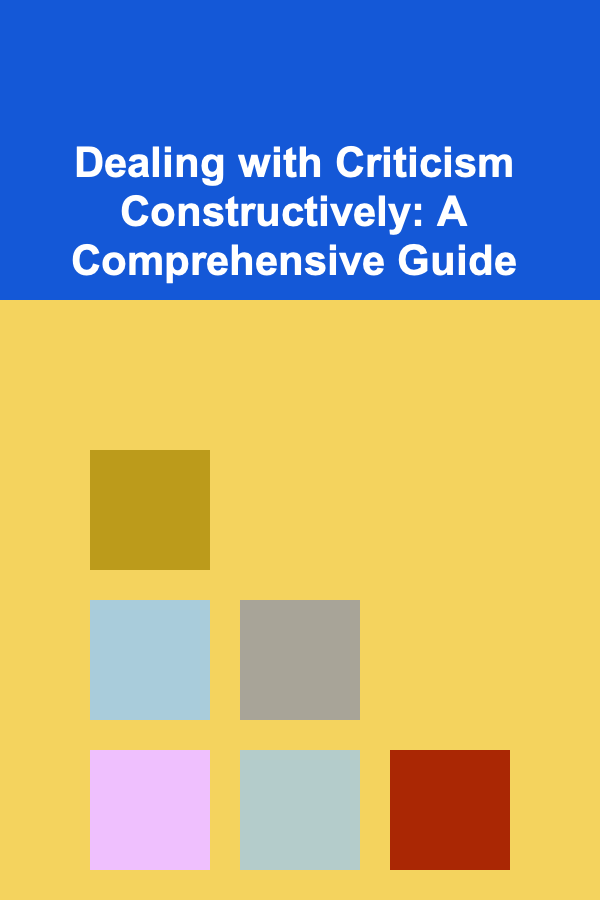
Dealing with Criticism Constructively: A Comprehensive Guide
ebook include PDF & Audio bundle (Micro Guide)
$12.99$10.99
Limited Time Offer! Order within the next:

Criticism, whether solicited or unsolicited, is an unavoidable part of life. From personal relationships to professional environments, we are constantly subject to feedback, judgments, and evaluations of our actions, work, and even our character. While the immediate reaction to criticism might be defensiveness, anger, or hurt, learning to deal with criticism constructively is a crucial skill for personal and professional growth. It allows us to identify areas for improvement, strengthen relationships, and ultimately become more resilient and effective individuals.
Understanding the Nature of Criticism
Before delving into strategies for handling criticism effectively, it's important to understand the different forms it can take and the motivations behind it. Criticism can be broadly categorized as:
- Constructive Criticism: This is criticism intended to be helpful and beneficial. It focuses on specific behaviors or actions and offers suggestions for improvement. It's usually delivered with the intention of helping you grow and develop.
- Destructive Criticism: This type of criticism is often delivered with the intent to harm or demean. It's usually vague, personal, and lacks specific suggestions for improvement. It often focuses on character flaws rather than specific actions.
- Valid Criticism: This is criticism that is based on factual inaccuracies or genuine areas where improvement is needed. It may be delivered constructively or destructively, but the underlying point is valid.
- Invalid Criticism: This is criticism that is based on incorrect assumptions, misinformation, or personal biases. While it might still sting, it lacks a solid foundation and should be evaluated accordingly.
Furthermore, it's crucial to understand the motivations behind the criticism. Is the person genuinely trying to help? Are they driven by envy, insecurity, or a desire to control? Understanding the motivation can help you filter the criticism and respond appropriately.
The Psychology of Criticism
Our brains are wired to prioritize survival, and criticism can be perceived as a threat. This triggers our "fight or flight" response, leading to defensiveness and resistance. Understanding this physiological reaction can help us consciously override it and approach criticism with a more rational mindset.
Here are some psychological factors that influence our response to criticism:
- Self-Esteem: Individuals with low self-esteem are more likely to internalize criticism and see it as confirmation of their negative self-perceptions.
- Perfectionism: Perfectionists often have difficulty accepting criticism, as it challenges their idealized view of themselves and their work.
- Past Experiences: Previous negative experiences with criticism can make us more sensitive and reactive to future feedback.
- Relationship with the Critic: The strength and nature of our relationship with the person delivering the criticism significantly impacts how we receive it. We are more likely to accept criticism from someone we trust and respect.
Developing a Constructive Response to Criticism: A Step-by-Step Guide
Learning to respond constructively to criticism is a skill that can be developed with practice. Here's a step-by-step guide to help you navigate critical feedback effectively:
1. Breathe and Resist the Initial Reaction
The first few seconds after receiving criticism are crucial. Your immediate reaction might be to defend yourself, argue, or shut down completely. Before you react, take a deep breath and consciously resist the urge to respond defensively. This allows you to calm your nervous system and approach the situation more rationally.
Consider using mindfulness techniques, such as focusing on your breath, to ground yourself in the present moment. This can help you detach from the emotional intensity of the situation and create space for a more thoughtful response.
2. Listen Actively and Seek Clarification
Once you've calmed your initial reaction, actively listen to what the person is saying. Pay attention not only to the words being used but also to the tone of voice and body language. Avoid interrupting or formulating your response while the person is speaking.
After the person has finished speaking, ask clarifying questions to ensure you understand their perspective. Examples of clarifying questions include:
- "Could you provide a specific example of what you mean?"
- "Can you elaborate on what you would like to see changed?"
- "What are the specific consequences of this issue?"
By seeking clarification, you demonstrate that you are genuinely interested in understanding the criticism and are willing to consider their perspective.
3. Acknowledge and Validate the Critic's Perspective
Even if you disagree with the criticism, it's important to acknowledge and validate the other person's perspective. This doesn't necessarily mean that you agree with them, but it shows that you respect their opinion and are willing to consider their point of view. Use phrases like:
- "I understand what you're saying."
- "I can see how you might feel that way."
- "I appreciate you bringing this to my attention."
Validating their perspective can diffuse tension and create a more collaborative environment. It also demonstrates empathy and willingness to understand their viewpoint, even if you ultimately disagree.
4. Separate the Message from the Messenger
It's easy to dismiss criticism simply because you dislike the person delivering it. However, it's important to separate the message from the messenger. Even if the person delivering the criticism is someone you don't respect or trust, the message itself might still contain valuable insights.
Focus on the content of the criticism, rather than the personality or motives of the person delivering it. Ask yourself: "Is there any truth to what they are saying, regardless of who is saying it?"
5. Identify Specific Areas for Improvement
Once you've understood the criticism, identify specific areas where you can improve. Focus on concrete actions and behaviors that you can change, rather than vague or abstract concepts. For example, instead of focusing on being "more creative," identify specific techniques or skills you can learn to enhance your creativity.
Write down these areas for improvement and develop a plan for addressing them. This shows that you are taking the criticism seriously and are committed to making positive changes.
6. Express Gratitude for the Feedback
Even if the criticism is difficult to hear, express gratitude for the feedback. This demonstrates maturity and a willingness to learn and grow. It also encourages the person to provide feedback in the future. Use phrases like:
- "Thank you for bringing this to my attention. I appreciate you taking the time to share your thoughts."
- "I value your feedback and will use it to improve my work."
- "I appreciate your honesty, even though it was difficult to hear."
Expressing gratitude can transform a potentially negative interaction into a positive one and strengthen your relationships.
7. Take Time to Reflect
After the conversation, take time to reflect on the criticism. Consider whether the criticism is valid and whether you agree with the suggestions for improvement. Don't be afraid to seek feedback from other sources to gain a more balanced perspective.
Use this reflection period to develop a plan for addressing the areas for improvement you identified earlier. Set realistic goals and track your progress. Remember that change takes time and effort, so be patient with yourself.
8. Decide on a Course of Action
Based on your reflection, decide on a course of action. This might involve implementing the suggestions for improvement, seeking additional training or resources, or simply agreeing to disagree with the critic. It is perfectly acceptable to disagree with criticism after careful consideration. Not all criticism is valid or helpful.
Document your decision and the reasons behind it. This will help you stay accountable and track your progress. It also provides a record of your response to the criticism, which can be useful in future discussions.
Dealing with Different Types of Criticism
The strategies for dealing with criticism vary depending on the type of criticism you are facing. Here's a breakdown of how to handle different types of critical feedback:
Constructive Criticism
Constructive criticism is generally easier to handle because it is intended to be helpful. Focus on understanding the specific suggestions for improvement and implementing them as effectively as possible. Remember to express gratitude for the feedback and ask clarifying questions if needed.
However, even with constructive criticism, it's important to evaluate the suggestions critically. Not all suggestions are created equal, and you may disagree with some of them. In such cases, politely explain your reasoning and propose alternative solutions.
Destructive Criticism
Destructive criticism can be more challenging to handle because it is often delivered with the intent to harm. It's important to remain calm and avoid getting drawn into an argument. Focus on extracting any valid points from the criticism, even if they are buried beneath layers of negativity.
If the criticism is purely personal and lacks any constructive elements, it's best to disengage from the conversation. Politely state that you are not interested in engaging in personal attacks and end the conversation. Remember, you are not obligated to accept abusive or disrespectful behavior.
Valid Criticism
Valid criticism, regardless of how it is delivered, should be taken seriously. Acknowledge the validity of the criticism and commit to addressing the underlying issues. Develop a plan for improvement and track your progress. Don't be afraid to seek help from others if needed.
Even if the criticism is delivered destructively, focus on the underlying truth and separate it from the negative tone. Remember that addressing valid criticism can lead to significant personal and professional growth.
Invalid Criticism
Invalid criticism is based on incorrect assumptions or misinformation. It's important to politely correct the inaccuracies and provide accurate information. If the person is unwilling to accept the correction, it's best to disengage from the conversation.
Don't waste your time trying to convince someone who is determined to hold onto their incorrect beliefs. Focus on protecting your own mental and emotional well-being and move on.
Common Pitfalls to Avoid When Dealing with Criticism
While learning to deal with criticism constructively, be aware of these common pitfalls that can hinder your progress:
- Defensiveness: The most common pitfall is becoming defensive and immediately rejecting the criticism. This prevents you from objectively evaluating the feedback and identifying areas for improvement.
- Taking it Personally: It's easy to take criticism personally, especially if it touches on sensitive areas. Remember that criticism is usually about your actions or behaviors, not your inherent worth as a person.
- Overthinking: Ruminating on criticism can lead to anxiety and self-doubt. Avoid overthinking and focus on taking concrete steps to address the feedback.
- Ignoring Criticism: Completely ignoring criticism can prevent you from identifying and addressing important issues. Even if the criticism is delivered poorly, try to extract any valuable insights.
- Seeking Constant Validation: While it's important to seek feedback, constantly seeking validation from others can make you overly dependent on their opinions. Learn to trust your own judgment and develop your own internal compass.
- Holding Grudges: Holding grudges against people who have criticized you can damage relationships and prevent you from moving forward. Practice forgiveness and focus on building positive relationships.
The Long-Term Benefits of Handling Criticism Constructively
Learning to handle criticism constructively is an investment in your personal and professional growth. The long-term benefits include:
- Improved Self-Awareness: By actively seeking and evaluating feedback, you gain a deeper understanding of your strengths and weaknesses.
- Enhanced Relationships: Handling criticism constructively strengthens relationships by fostering trust and open communication.
- Increased Resilience: Learning to bounce back from criticism builds resilience and helps you cope with adversity.
- Greater Professional Success: By addressing areas for improvement, you enhance your skills and become a more valuable asset to your organization.
- Improved Emotional Intelligence: Dealing with criticism effectively requires emotional intelligence, including self-awareness, empathy, and self-regulation.
- Personal Growth: Ultimately, learning to handle criticism constructively fosters personal growth and helps you become a more well-rounded and effective individual.
Conclusion
Dealing with criticism constructively is a lifelong journey that requires practice, patience, and a willingness to learn. By understanding the nature of criticism, developing a constructive response, and avoiding common pitfalls, you can transform criticism from a source of pain and frustration into an opportunity for growth and improvement. Embrace criticism as a valuable tool for personal and professional development, and you will be well on your way to becoming a more resilient, effective, and successful individual. Remember that the ability to learn from feedback and adapt to changing circumstances is a crucial skill in today's rapidly evolving world.

How to Make the Most of a Small Space with Holiday Decorations
Read More
How to Make the Most of Holiday Decor with Small Touches Around the House
Read More
How to Use Academic Writing to Make Money
Read More
How to Use Furniture with Built-In Storage for Small Homes
Read More
Building Functional Strength for Daily Activities: A Comprehensive Guide
Read More
How to Determine the True Cost of a Private Education
Read MoreOther Products

How to Make the Most of a Small Space with Holiday Decorations
Read More
How to Make the Most of Holiday Decor with Small Touches Around the House
Read More
How to Use Academic Writing to Make Money
Read More
How to Use Furniture with Built-In Storage for Small Homes
Read More
Building Functional Strength for Daily Activities: A Comprehensive Guide
Read More